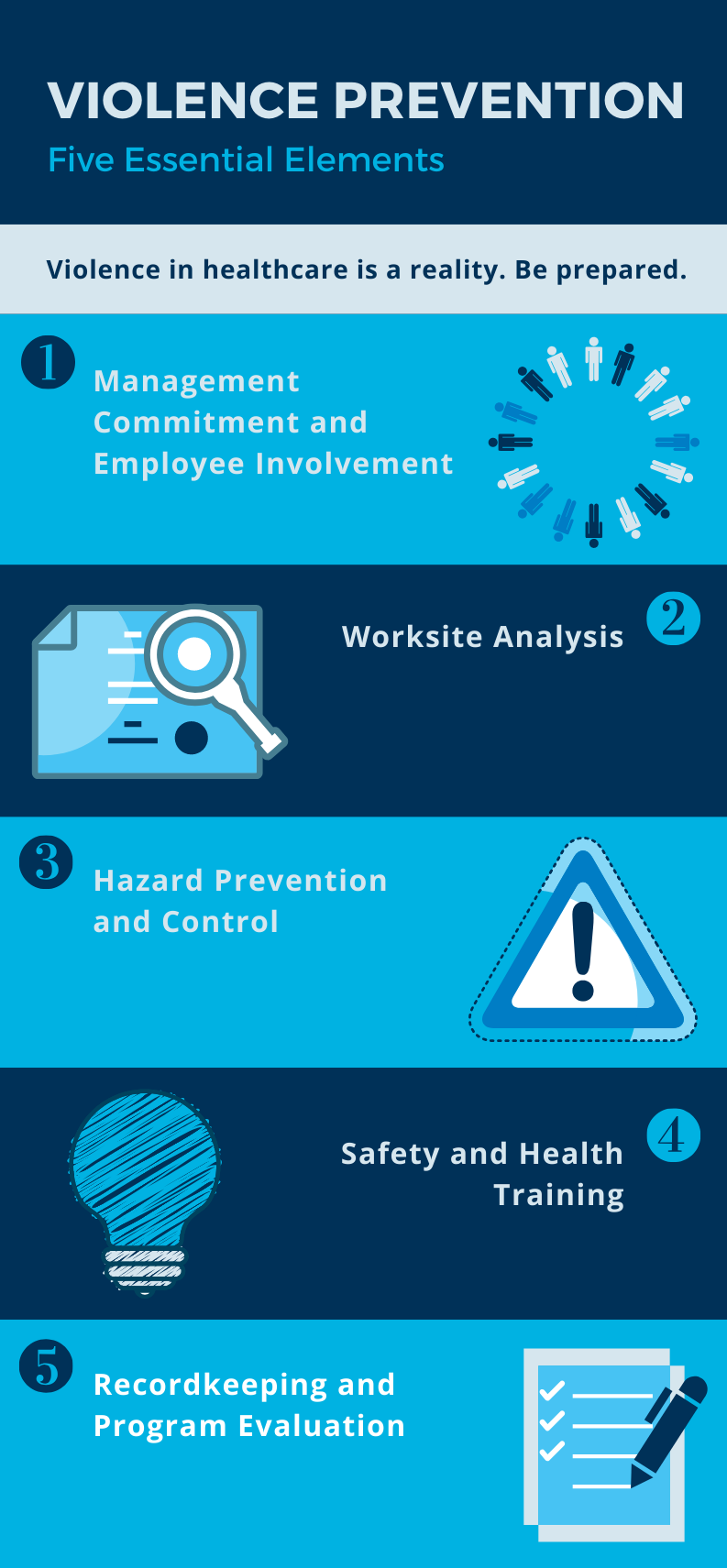Practical Steps for Enhancing California Workplace Violence Prevention in Your Company
Practical Steps for Enhancing California Workplace Violence Prevention in Your Company
Blog Article
The Duty of Staff Member Training and Understanding in Enhancing Office Physical Violence Prevention Initiatives Across Different Industries
The combination of employee training and recognition right into workplace violence avoidance efforts is progressively recognized as an essential aspect of organizational safety and security throughout diverse sectors. By executing targeted training programs, services can effectively encourage their labor force to determine and resolve potential risks prior to they escalate. Nevertheless, the performance of these initiatives commonly rests on several essential aspects that differ by field, elevating vital inquiries about the adaptability of training approaches and their real-world impact. Understanding these nuances might disclose approaches that can dramatically improve safety and security methods and employee self-confidence in high-risk settings.
Relevance of Training Programs
In today's vibrant workplace, the relevance of training programs can not be overstated, particularly in the context of office physical violence prevention. These programs serve as a fundamental element in cultivating a secure and safe office society. By outfitting workers with the expertise and abilities essential to recognize, reduce, and react to prospective threats, organizations can promote an atmosphere that prioritizes safety and security and well-being.
Reliable training programs do greater than simply instruct; they empower employees to recognize caution signs of violence, understand the protocols for reporting occurrences, and develop methods to de-escalate prospective conflicts. In addition, they instill a feeling of collective duty among team, urging proactive participation in preserving a risk-free work environment.
Investment in training not only improves worker awareness yet likewise shows an organization's commitment to safeguarding its workforce. This positive approach can bring about decreased incidents of office violence, lower absenteeism, and enhanced employee spirits. Eventually, thorough training programs are important to developing a resistant business society that values safety and security and promotes a healthy work setting, consequently minimizing the threat of physical violence and its connected repercussions.
Secret Elements of Effective Understanding
A detailed recognition program encompasses several key elements that are vital for efficiently stopping work environment physical violence. Initially, clear communication of policies and procedures associated with office physical violence is crucial. Staff members must be informed about the company's position on violence and the certain procedures in position for reporting events.
Second, training sessions ought to incorporate reasonable scenarios that staff members may experience. This functional approach helps employees identify cautioning indicators of prospective violence and equips them with the necessary abilities to de-escalate stressful circumstances. Third, fostering a supportive workplace culture is crucial; employees must really feel empowered to talk up without anxiety of revenge.
Integrating responses systems permits workers to share their experiences and understandings, which can lead to continuous improvement of awareness initiatives. By incorporating these elements, organizations can create a durable framework for protecting against office violence, inevitably adding to a more secure and more productive environment for all workers (california workplace violence prevention).
Industry-Specific Training Methods
Efficient work environment physical violence prevention training must be customized to the distinct challenges and risks encountered by particular markets. For example, healthcare settings need training that addresses the high probability of experiences with aggressive people or visitors. Programs should focus on de-escalation strategies, identifying caution indicators of possible physical violence, and guaranteeing staff recognize the importance of reporting events.
In comparison, retail setups may deal with different dangers, such as burglary or consumer conflicts. Training in these settings must highlight situational understanding, action protocols throughout emergency situations, and the importance of safeguarding cash money and valuables.
Manufacturing and building sectors offer their own risks, frequently associated with social problems or hazardous working problems. Training in these markets ought to consist of approaches for problem resolution, promoting a society of security, and encouraging open communication among workers.
In addition, company offices might require training focused on protecting against harassment and intimidation, cultivating a considerate office society, and implementing clear reporting systems. Each industry must not only identify its certain vulnerabilities yet additionally adapt training materials to reverberate with the labor force properly, making sure that staff members really feel complete and encouraged to manage prospective fierce scenarios.
Gauging Training Effectiveness
Reviewing the effect of workplace physical violence prevention training is important for making sure that staff members are adequately prepared to handle potential dangers. To properly determine training efficiency, companies must carry out both measurable and qualitative evaluation methods. Pre- and post-training studies can gauge modifications in staff member understanding, attitudes, and behaviors concerning work environment violence. These studies need to concentrate on specific training goals to make certain alignment with the organization's objectives.
Additionally, sensible analyses, such as role-playing scenarios or simulations, can give insights into exactly how well employees apply discovered abilities in real-life scenarios. Checking event records prior to and after training can also serve as an indication of effectiveness, as a decrease in cases might reflect enhanced staff member readiness.
Furthermore, feedback from participants ought to be methodically collected to determine areas for improvement in training material and delivery. Performing follow-up evaluations at regular intervals helps endure understanding and strengthens training principles with time - california workplace violence prevention. By employing a thorough technique to gauging training efficiency, companies can ensure that their work environment violence avoidance initiatives foster a much safer setting and Our site enhance general employee well-being
Building a Society of Safety And Security

Educating plays a pivotal function in this social change. Regular, comprehensive training sessions enlighten staff members regarding identifying caution indications of workplace violence and the suitable responses. Furthermore, motivating open interaction allows staff members to voice problems without fear of retaliation, advertising cumulative duty for safety and security.
In addition, integrating safety into day-to-day operations ensures that it comes to be a common worth as opposed to a mere conformity problem. This consists of routine navigate to this website safety drills, updates on plans, and feedback devices that entail staff members in security discussions and enhancements.
Inevitably, a durable society of security not only mitigates the risks of office physical violence but also enhances employee morale and efficiency. By fostering an environment where security is a basic concern, organizations can create resistant offices that sustain both private health and cumulative success.
Conclusion
Finally, staff member training and awareness are important elements in the avoidance of office physical violence across numerous industries. Reliable training programs, tailored to certain sector requirements, boost staff members' capability to react and acknowledge to potential hazards. By carrying out extensive understanding strategies and cultivating a culture of safety and security, companies can dramatically minimize incidents of office violence and enhance overall employee spirits. Dedication to continuous training and evaluation makes certain continual effectiveness and versatility in attending to emerging difficulties within the office environment.

Regular, detailed training sessions educate employees about recognizing warning signs of office violence and the ideal reactions.In conclusion, employee training and awareness are crucial elements in the avoidance of work environment violence across various sectors.
Report this page